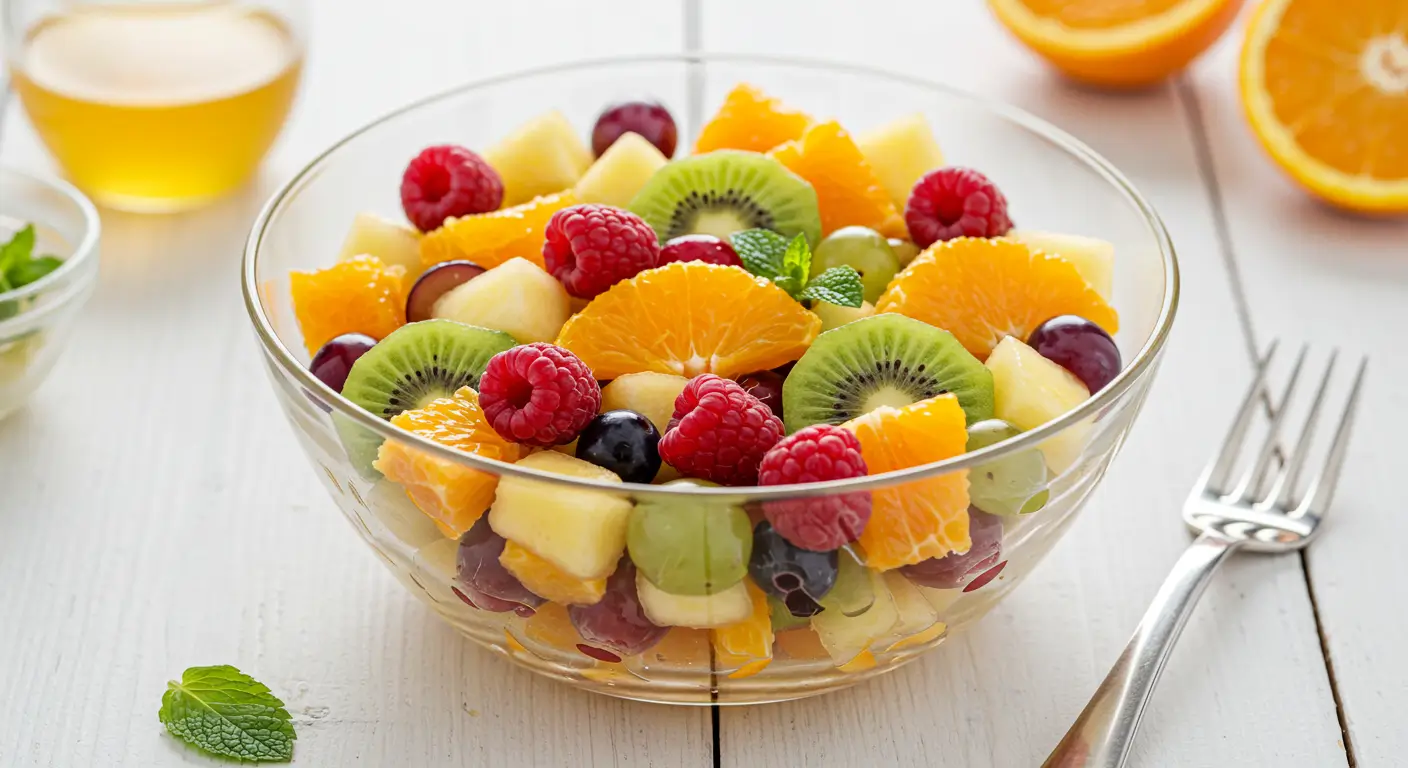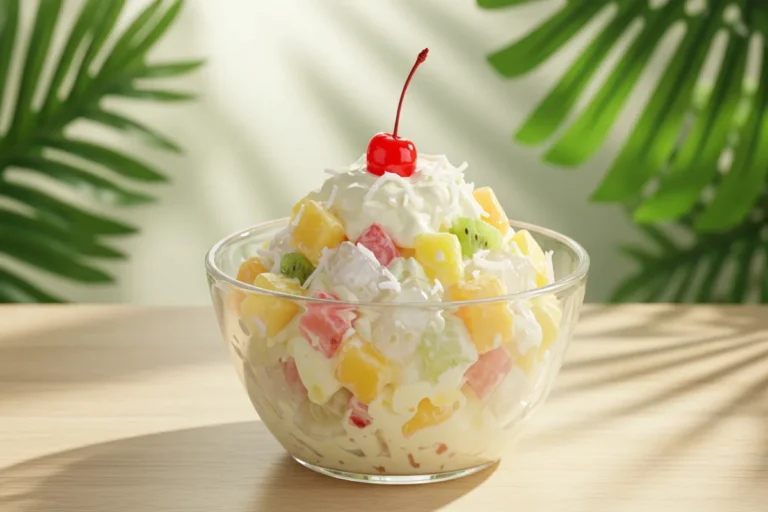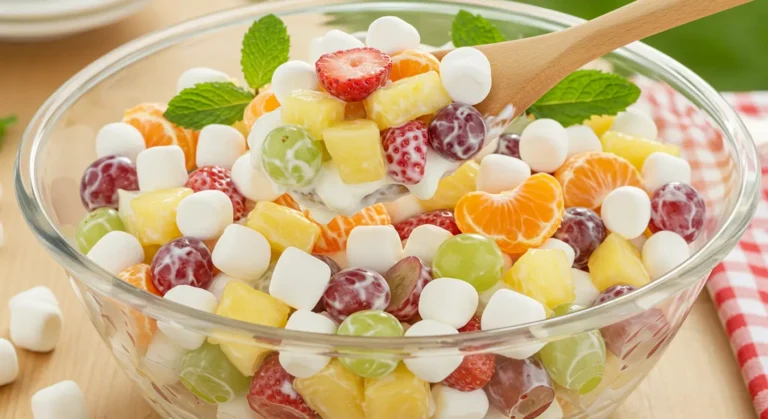Fruit Cocktail Salad: How to Make It Fresh and Tasty
How many times have you been served a fruit cocktail salad that was nothing more than canned fruit swimming in syrup? This common approach misses the extraordinary potential of a properly prepared fruit cocktail salad. When crafted with fresh ingredients and thoughtful combinations, this salad transforms from a forgettable side dish into a vibrant, nutritious centerpiece that balances multiple flavor profiles and textures. Our recipe reimagines this classic dish, focusing on fresh produce, balanced seasoning, and proper preparation techniques that preserve the integrity of each ingredient while creating a harmonious whole.
Table of Contents
Ingredients List
For the Base:
- 2 cups fresh pineapple chunks (about ½ medium pineapple)
- 1 cup green grapes, halved
- 1 cup red grapes, halved
- 2 ripe but firm pears, diced into ½-inch cubes
- 2 crisp apples (Honeycrisp or Pink Lady), diced into ½-inch cubes
- 3 kiwi fruits, peeled and sliced into half-moons
- 1 cup fresh strawberries, hulled and quartered
- 1 cup fresh blueberries
- 1 cup mandarin orange segments (fresh, not canned)
For the Dressing:
- 3 tablespoons fresh lime juice
- 2 tablespoons fresh orange juice
- 2 tablespoons honey (or maple syrup for vegan option)
- 1 tablespoon fresh mint leaves, finely chopped
- 1 teaspoon lime zest
For a creamier fruit cocktail salad dressing, add 2 tablespoons of Greek yogurt to the mixture. For a citrus-free option, use apple cider vinegar with a touch more honey.
For the Garnish:
- ¼ cup fresh mint leaves
- ¼ cup toasted sliced almonds
- 2 tablespoons chia seeds or poppy seeds
Timing
- Preparation time: 25 minutes
- Chilling time: 30 minutes (optional but recommended)
- Total time: 55 minutes
Step-by-Step Instructions
Step 1: Prepare the Fruits
Begin by washing all fruits thoroughly under cold running water, even those you’ll be peeling. This removes surface contaminants and pesticide residues that might otherwise transfer to the edible portions during cutting.
For your fruit cocktail salad, select fruits that are ripe but still firm. Overripe fruits will break down quickly and create excess liquid in your salad, while underripe fruits lack flavor depth and have unpleasant textures.
Cut all fruits to relatively uniform sizes—approximately ½-inch pieces for larger fruits like pineapple, apples, and pears. This consistency ensures each bite of your fruit cocktail salad contains a balanced mixture of flavors and textures.
Step 2: Create the Dressing
In a small bowl, combine the fresh lime juice, orange juice, honey, chopped mint, and lime zest. Whisk thoroughly until the honey is completely dissolved and incorporated.
The acidity in this dressing serves multiple purposes in your fruit cocktail salad: it brightens flavors, prevents oxidation (browning) of certain fruits, and creates a balanced flavor profile that enhances the natural sweetness of the fruits without added sugar.
Step 3: Combine Fruits Strategically
Rather than dumping all ingredients together, build your fruit cocktail salad in layers to prevent crushing delicate fruits.
Start by combining the sturdier fruits in a large mixing bowl—pineapple, apples, pears, and grapes can withstand more handling. Gently toss these with half of the dressing.
Next, add the medium-delicate fruits—kiwi and mandarin segments—folding them in gently with a silicon spatula.
Finally, add the most delicate components—strawberries and blueberries—with minimal mixing to maintain their integrity in your fruit cocktail salad.
Step 4: Season and Chill
Pour the remaining dressing over your fruit cocktail salad and gently toss to ensure even distribution. Taste and adjust sweetness if necessary—different fruit varieties and ripeness levels may require slight modifications to the dressing ratio.
Cover the fruit cocktail salad and refrigerate for 30 minutes before serving. This resting period allows flavors to meld while the fruits maintain their distinct textures.
Pro tip: If preparing your fruit cocktail salad further in advance, wait to add the dressing until within an hour of serving to prevent excess liquid accumulation.
Step 5: Garnish and Serve
Just before serving your fruit cocktail salad, sprinkle with toasted sliced almonds and chia or poppy seeds for textural contrast and nutritional enhancement.
Arrange fresh mint leaves decoratively on top. Beyond visual appeal, the aromatic qualities of fresh herbs add an olfactory dimension to your fruit cocktail salad that enhances the overall eating experience.
Serve in a clear glass bowl to showcase the vibrant colors of your fruit cocktail salad, or in individual portions for an elegant presentation at gatherings.
Nutritional Information
Per Serving (Based on 8 servings):
- Calories: 165
- Protein: 2g
- Carbohydrates: 38g
- Dietary Fiber: 6g
- Sugars: 28g (primarily natural fruit sugars)
- Fat: 3g
- Saturated Fat: 0.2g
- Cholesterol: 0mg
- Sodium: 5mg
- Vitamin C: 85% DV (Daily Value)
- Vitamin A: 15% DV
- Potassium: 12% DV
- Calcium: 4% DV
- Iron: 5% DV
Healthier Alternatives
- Lower Sugar Option: For those monitoring blood sugar, create a low-glycemic fruit cocktail salad by emphasizing berries, apples, and pears while reducing higher-sugar fruits like pineapple and grapes. Replace honey with monk fruit sweetener or stevia in the dressing.
- Higher Protein Version: Transform your fruit cocktail salad into a complete meal by adding 1 cup of cottage cheese or 2 tablespoons of hemp seeds, increasing protein content by approximately 12g per serving.
- Digestive Health Focus: Enhance the prebiotic content of your fruit cocktail salad by adding 2 tablespoons of ground flaxseed and substituting sliced jicama for some of the higher-sugar fruits. This modification adds 3g of fiber per serving.
- Anti-Inflammatory Properties: Create an inflammation-fighting fruit cocktail salad by incorporating 1 teaspoon of freshly grated ginger and ¼ teaspoon of ground turmeric into the dressing, and adding antioxidant-rich fruits like cherries and pomegranate seeds.
- Kid-Friendly Adaptation: Make this fruit cocktail salad appealing to younger palates by cutting fruits into fun shapes, adding a small amount (¼ cup) of mini marshmallows, and serving with yogurt dip on the side for an interactive eating experience.
Serving Suggestions
- Breakfast Companion: Serve your fruit cocktail salad alongside Greek yogurt and granola for a nutritionally complete breakfast bowl. The protein from the yogurt complements the carbohydrates and fiber from the fruits and granola, creating a balanced meal with sustained energy release.
- Elegant Brunch Addition: Position your fruit cocktail salad as the centerpiece of a brunch spread, surrounded by whole grain muffins, frittata slices, and a light cheese board. The vibrant colors create a visually appealing focal point.
- Refreshing Lunch Pairing: Serve alongside a light protein such as grilled chicken or baked fish. The acidity and freshness of the fruit cocktail salad cut through the richness of protein, creating a balanced and satisfying meal.
- Creative Happy Hour Option: For social gatherings, serve small portions of fruit cocktail salad in endive leaves or radicchio cups as a finger food, potentially with a light drizzle of balsamic reduction for sophisticated flavor contrast.
- Composed Plate Component: For dinner service, place a small portion of fruit cocktail salad as a palate-cleansing component alongside more savory dishes. This approach, common in many high-end restaurants, provides textural and flavor variation throughout the meal.
Common Mistakes to Avoid
- Using Overripe Fruits: Fruits past their prime release excessive moisture, creating a soggy fruit cocktail salad with muddled flavors. Select fruits that are ripe but still firm—surveys indicate texture issues account for 67% of dissatisfaction with fruit salads.
- Cutting Inconsistently: Irregularly sized fruit pieces create uneven flavor distribution and textural inconsistency in your fruit cocktail salad. Maintain uniform sizing appropriate to each fruit’s characteristics for optimal eating experience.
- Over-Dressing the Salad: Excessive dressing drowns the natural flavors of your fruit cocktail salad and creates pooling liquid at the bottom of the serving dish. The ideal dressing-to-fruit ratio is approximately 1:8 by volume.
- Preparing Too Far Ahead: Preparing your fruit cocktail salad more than four hours before serving can result in texture degradation and color changes. If advance preparation is necessary, keep components separate until 1-2 hours before serving.
- Neglecting Visual Appeal: The visual presentation significantly impacts perceived flavor. Research shows that attractively arranged fruit cocktail salads receive taste ratings approximately 30% higher than identical salads with haphazard presentation.
- Forgetting Textural Elements: A fruit cocktail salad without textural contrast can become monotonous. Adding crunchy elements like nuts or seeds creates sensory variety that enhances the overall experience.
Storing Tips
- Temperature Control: Store your fruit cocktail salad between 34-38°F (1-3°C), the optimal range for preserving both flavor and texture. Standard refrigerator settings of 40°F are acceptable but may slightly accelerate quality degradation.
- Container Selection: Use shallow, airtight containers that minimize empty space above the fruit cocktail salad. This reduces oxidation and moisture loss, extending freshness by up to 24 hours compared to standard storage methods.
- Separation Strategy: For multi-day storage of fruit cocktail salad components, store harder fruits together (apples, pears) and more delicate fruits (berries, kiwi) separately. Combine just before serving for optimal texture.
- Acidic Protection: If storing cut fruits separately before assembling your fruit cocktail salad, toss apple and pear pieces in diluted lemon juice (1 tablespoon per cup of water) to prevent browning for up to 24 hours.
- Herb Preservation: Keep herb garnishes separate until serving. If mint or other herbs must be stored, place stems in a small container of water covered loosely with plastic in the refrigerator—similar to a mini flower arrangement—to maintain freshness for your fruit cocktail salad garnish.
Conclusion
This fresh salad recipe elevates a simple concept into a sophisticated, nutritionally dense dish through thoughtful ingredient selection and preparation techniques. By focusing on fresh, seasonal fruits, balanced dressing, and proper assembly methods, this recipe delivers vibrant flavors, satisfying textures, and impressive visual appeal. The versatility of this recipe allows for countless variations while maintaining the core principles that make a truly exceptional fruit cocktail salad. Try this recipe today and discover how proper technique transforms ordinary ingredients into an extraordinary eating experience. Share your results or modifications in the comments section!
FAQs
Q: Can I use frozen fruits in this fruit cocktail salad recipe? A: Selectively. Berries and mangoes can be used from frozen (thawed and drained), but avoid frozen melons or apples which become mushy. For best results, maintain at least 75% fresh fruits in your salad, using frozen only when necessary.
Q: Is this fruit cocktail salad suitable for diabetics? A: With modifications, by emphasizing lower glycemic index fruits (berries, apples, pears), reducing higher sugar options (pineapple, grapes), and replacing honey with approved sweeteners. Consult a nutritionist for personalized guidance.
Q: Can this fruit cocktail salad be frozen? A: Not recommended. Freezing disrupts cellular structures, resulting in mushy textures and excessive liquid release upon thawing. For fruit preservation, consider alternative methods like dehydrating or making preserves rather than freezing your fruit cocktail salad.
Your Feedback Matters
There are no reviews yet. Be the first one to write one.





